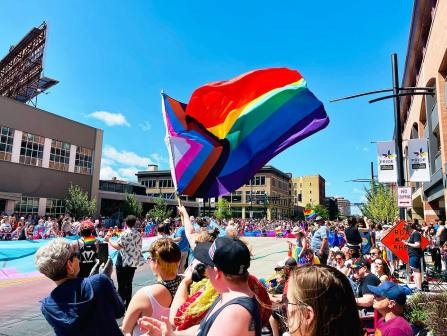The Pride Parade Minneapolis 2025 has once again transformed the streets of downtown Minneapolis into a vibrant celebration of love, diversity, and resilience. Held on June 29, 2025, this iconic event, part of the Twin Cities Pride Festival, drew over 200,000 attendees, making it one of the largest Pride parades in the United States. The parade, which kicked off at 11 a.m. along Hennepin Avenue, showcased colorful floats, lively performances, and a powerful sense of community. Despite a brief disruption by a small group of protesters, the event remained a joyous testament to the strength of the LGBTQ+ community and its allies. Here’s a deep dive into the latest developments surrounding this year’s Pride Parade Minneapolis.
A Colorful Procession Down Hennepin Avenue
The Pride Parade Minneapolis 2025 began at 3rd Street and Hennepin Avenue, winding its way to Spruce Street. Crowds lined the streets, cheering as floats adorned with rainbow flags and messages of equality rolled by. Local organizations, businesses, and community groups participated, with many showcasing creative displays. The event featured an accessibility grandstand with interpreters and wheelchair spots, ensuring inclusivity for all attendees. Metro Transit provided free rides throughout the weekend, making it easier for people to join the celebration. The parade’s theme, “Pride in Every Stride,” resonated through the energetic Rainbow Run 5K, which took place earlier that morning, with participants donning vibrant outfits to race down the parade route.
Key Highlights of the Parade
- Grand Marshal Recognition: Minnesota Governor Tim Walz was honored as the 2025 Grand Marshal, celebrated for his advocacy for LGBTQ+ rights.
- Youth Engagement: The Rainbow Stage featured performances exclusively for LGBTQ+ youth, fostering a safe and empowering space.
- Community Support: Over 650 vendors, including BIPOC and LGBTQ+-owned businesses, lined Loring Park, offering everything from crafts to resources.
- Accessibility Focus: ADA bathrooms and shuttle services ensured the event was welcoming to those with mobility challenges.
Navigating Challenges with Resilience
The Pride Parade Minneapolis faced a minor hiccup when a group advocating for Palestine and protesting “corporate Pride” briefly halted the procession at 9th and Hennepin. The demonstration, which included a five-minute “die-in,” lasted about 20 minutes before the parade resumed. While some attendees expressed frustration, the incident highlighted the intersectional nature of modern Pride events, where social justice issues often intertwine with celebrations of identity. Organizers quickly regained momentum, ensuring the event continued with its uplifting spirit intact. Social media posts reflected a mix of sentiments, with many praising the parade’s ability to adapt and shine despite the disruption.
The Twin Cities Pride Festival, held in Loring Park on June 28 and 29, complemented the parade with a bustling lineup of activities. Four stages hosted live music, drag shows, and performances by local BIPOC and LGBTQ+ artists. The festival, free to the public, featured a Family Services Tent with air-conditioned spaces for families, a Sober Pride area for those celebrating in sobriety, and a Pet Central zone for animal lovers. The newly renamed Club Loring, formerly the beer garden, offered DJ sets, yard games, and a photo booth, creating a lively atmosphere. The festival’s commitment to inclusivity was evident in its support for marginalized communities, with stickers identifying BIPOC and LGBTQ+-owned vendors.
Community Impact and Future Vision
The Pride Parade Minneapolis 2025 wasn’t just a celebration—it was a statement of solidarity in a time when LGBTQ+ rights face ongoing challenges. Twin Cities Pride, a nonprofit, used proceeds from events like the Rainbow Run to fund year-round programs, including youth camps, sports scholarships, and a gender-affirming Rainbow Wardrobe. The festival’s mission to empower every LGBTQ+ person to live authentically resonated deeply with attendees. Looking ahead, organizers are already planning for 2026, with parade registration set to open in January. The event’s ability to draw over 400,000 visitors to the Twin Cities underscores its cultural and economic significance, with an estimated $43.8 million in event spending.
Join the celebration of love and equality by planning your visit to the Pride Parade Minneapolis 2026! Volunteer, support local vendors, or simply show up to spread joy. Follow Twin Cities Pride on social media for updates and get ready to march with pride next year!
